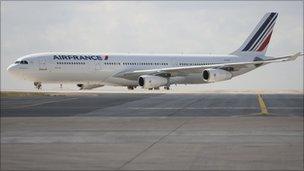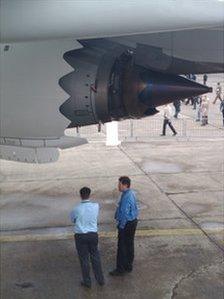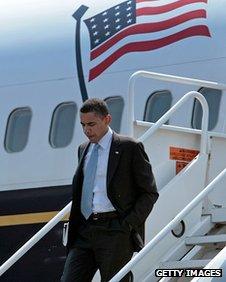Making the skies safer, cleaner and cheaper to manage
- Published
Efforts to reduce noise and emissions whilst improving profits and safety records, have been focused on improving aircraft and engines
The extensive and clear overview from the control tower at Brno airport enables the air traffic managers here to calmly control the airspace above.
Getting a similarly clear view of how the European skies they help keep safe are managed is much harder.
From whichever angle you look at Europe's air traffic management system, it seems to be in a sorry state.
True, the system does deliver when it comes to safety - and that is obviously the main concern.
But it is also fragmented, costly and wasteful, according to Patrick Ky, who as head of a European modernisation air traffic control programme, Sesar, is in charge of putting the it right.
"There are inefficiencies in the system," says Mr Ky, pointing out that in Europe there are 36 air traffic service providers and 58 en-route centres.
By comparison, in the US there is just one air traffic service provider and 21 en-route centres, even though it controls air space that is somewhat larger.
Economic impact
Mr Ky acknowledges that "there are historical and cultural reasons" why the European system is so complex.

Helping planes land quickly rather than circle over airports helps cut noise, pollution and costs
For instance, in Europe much of the air space over each European country is reserved for various air force activities.
"The Swiss Air Force needs to train over Switzerland," Mr Ky explains, picking an example.
Hence, flights between Milan and Amsterdam are having to fly around the Swiss no-fly zone, adding 155km (100 miles) - or more than 25% - to the route and thus burning 448kg more fuel and emitting 1,413kg more carbon dioxide (CO2).
This illustrates that there will always be certain problems that better air traffic management cannot easily solve in Europe.
Nevertheless, Mr Ky is eager to stress that sorting out the stuff that can be fixed could deliver savings and other economic benefits in excess of a whopping 400bn euros (£340bn; $545bn) - including the creation of 328,000 jobs - in return for a 30bn euros investment over a 15-20 year period.
"It'd have a massive impact on the economy," he says.
Congested skies
If that was the carrot, there is also a stick.
Unless Europe's current air traffic management system is completely overhauled, it will simply crumble under the weight of an anticipated surge in the number of flights in the years ahead, and thus fail to grow in a safe and economically viable manner, the European Commission (EC) warns.
Modernising air traffic management systems in Europe could help cut costs and emissions
"Air traffic growth is pushing air transport systems to their limits worldwide, and certainly this is the case in Europe," Matthias Ruete, head of the EC transport policy body DG Move, said in a speech in September.
"More and more airspaces and airports are becoming congested. We know what this means: delays, increasing flight distance, and fuel consumption, damages to our environment, and additional costs and discomfort for passengers.
"With growing congestion, we cannot afford to hesitate."
Triple whammy
On an industrial site a short drive from Brno airport, the technology company Honeywell Aerospace has established a division to come up with a solution.
The challenge, according to Paolo Carmassi, the company's boss in Europe and other regions, is to figure out how European air space can be used much more efficiently, while at the same time delivering a number of improvements, such as:
better safety
reduced costs - both air traffic management costs as well as costs for airport operators, airlines and passengers
reduced environmental impact, both in terms of harmful emissions and noise.
"There's a direct link between the time spent in the air burning fuel, the cost of operations and the emissions and noise pollution," says Mr Carmassi.
Consequently, delivering one of these interdependent objectives will help deliver the other two.
Fourth dimension
Replacing old technology with new is the first required step towards reaching these goals, according to Mr Carmassi.
"Today, we're largely relying on 20th Century technology," he says.

Reducing the time engines are run helps reduce costs and emissions
"Existing VHF radio frequencies for communication is overcrowded, unreliable and limited in scope.
"There's a huge amount of safety-critical information that needs to be conveyed between an aircraft and the ground, and that we don't want radio DJs or anyone else to interfere with."
Moreover, he adds, current radar systems are unable to stack incoming flights sufficiently close together.
Replace both VHF radio and radar systems with modern satellite systems and modern air traffic management systems can move from being merely three-dimensional, Mr Carmassi explains.
"It's about adding the fourth dimension, namely time," he says.
"Think of satellite technology - as opposed to radar technology - as a tool that enables us to pinpoint flights, now and in the future."
Knowing exactly where a plane will be at any point in time during its entire journey enables air traffic controllers to line them up and sequence them so that they can land with intervals of just two minutes.
This boosts the utilisation of each runway, both at large hubs and regional airports, while at the same time eliminating the need for planes to circle over airports while waiting for landing slots.
Additional technology on-board the aircraft, which helps pilots land planes even when visibility is extremely poor, makes the system even more reliable, Mr Carmassi explains as he demonstrates how it works in a flight simulator.
The technology includes a synthetic view of the landscape ahead, as well as an infrared camera that gives pilots a real-time view of the situation ahead of them.
The technology means the pilots can take the plane almost all the way down before they need to actually see the runway, reducing the number of failed landing attempts during bad weather, thus saving time, fuel and money.
Global issues
The technology has been proven to work, and introducing it is essential to reform the air traffic management system, Sesar's Mr Ky agrees.
"We cannot change the system without a complete change in technology," he says.

President Barack Obama has made it a priority to improve US air traffic management
"So the problem is not technology per se," he continues. "It's certification of the system.
"We want to build a system that can handle three times more traffic than the current one does today, with the same level of safety, while at the same time aiming to cut the environmental impact by up to 10% and cut air traffic management costs by 50% from 8bn euros to 4bn euros," says Mr Ky.
"But it's extremely complex, as when you change one thing on one side you also have to make sure it is changed on-board the aircraft and on the other side."
To sort it out, Sesar has employed some 2,500 people from 23 countries. "This is one of the biggest projects of the European Union at this point," says Mr Ky.
Moreover, "air traffic control is a global issue", Mr Ky adds - and it is one that requires extensive cross-border co-operation and co-ordination to get right.
In the US, the Obama administration has made it a key priority to sort out its air management control system. In Asia, authorities are eager to get it right the first time as they gear up for a massive expansion in aviation. In the Middle East, it is emerging as a major challenge as 80% of air space is military, with the remaining 20% increasingly congested.
And yet, in spite of the necessity and the predicted benefits, nobody expect a quick fix.
"The current economic situation does not make things easier," Mr Ky observes, pointing out that it would take five to 10 years to see the benefits from any investments.
"It is difficult for governments to make those decisions now," he says.
The Dubai Airshow runs from 13 to 17 November 2011.